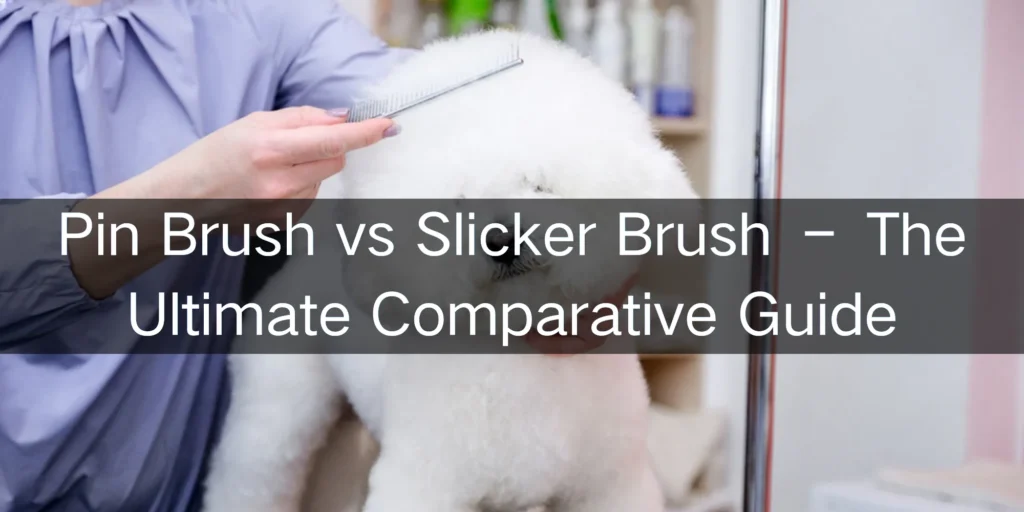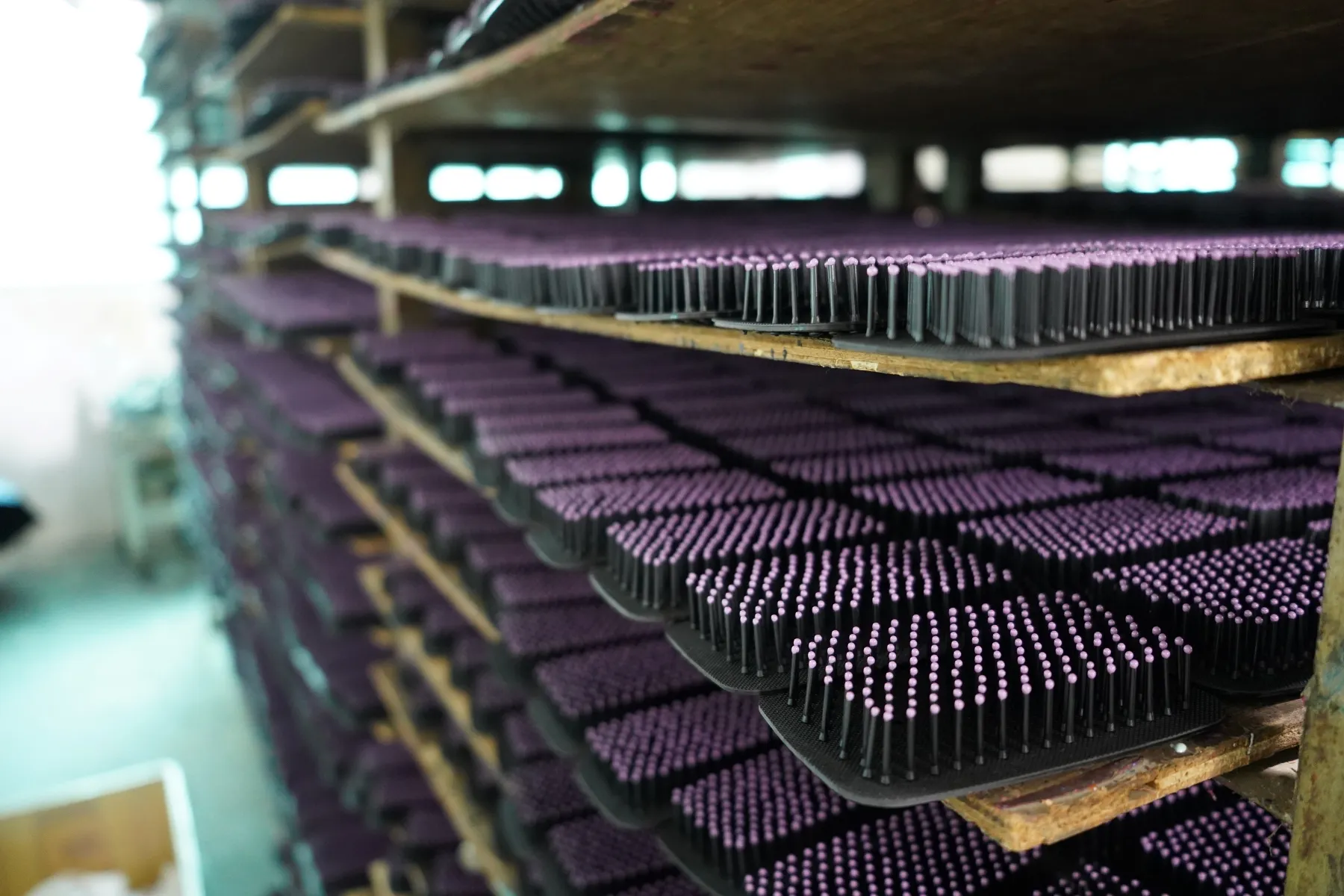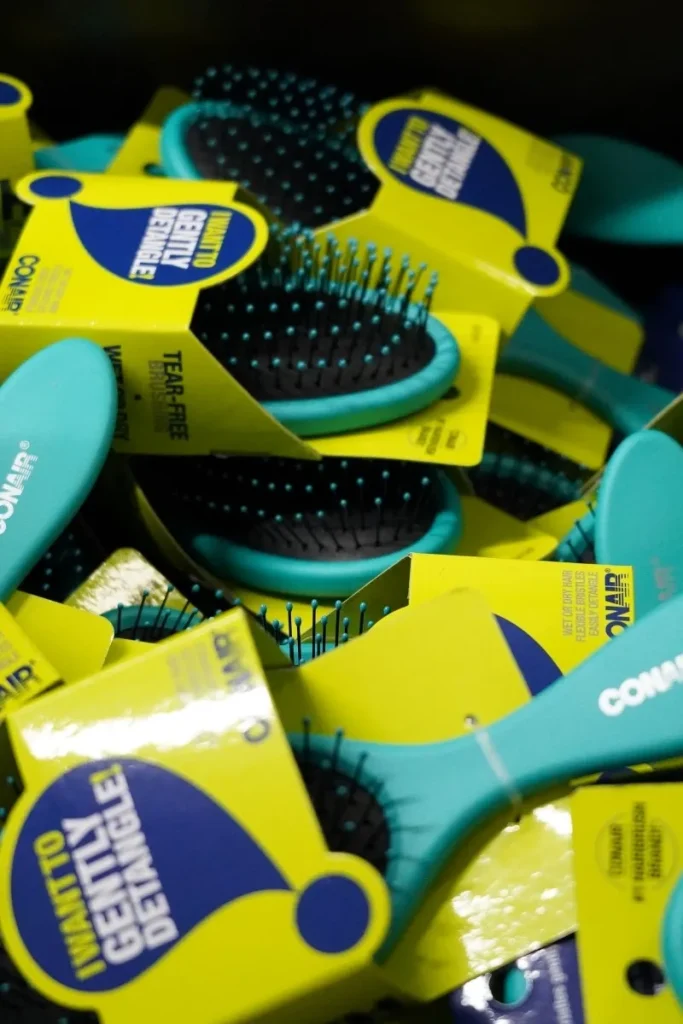The decision to use a pin brush vs slicker brush is one of the major steps to ensuring that the coat of your pet remains healthy and mat-free. The distinction between the two is important since each brush has its best application in certain types of coats and needs of grooming. This article describes the nature of a pin brush, its comparison with a slicker brush, and the situations when to use the two. At the end, you will learn their features, advantages, how to use them, and what pitfalls to avoid.
What is a Pin Brush?
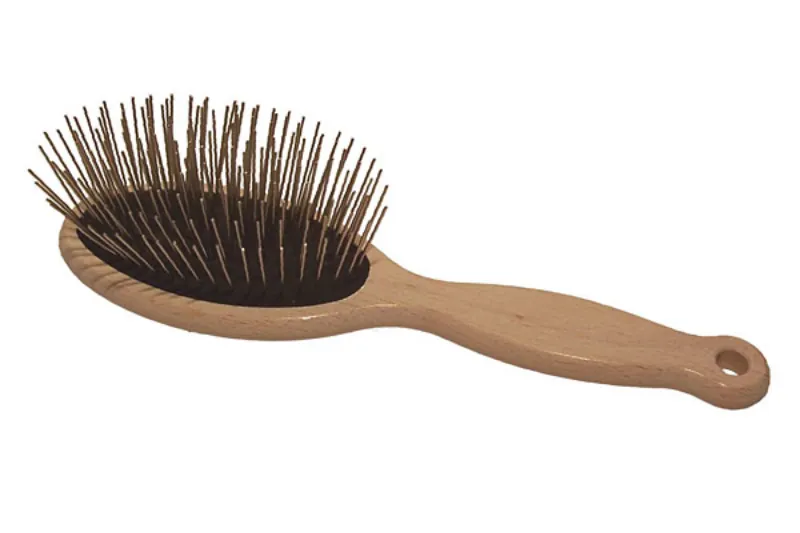
A pin brush is a grooming tool that resembles your hairbrush greatly. Has straight metal or wire pins that have rounded ends and thus allow you to unravel your dog hair and smooth it gently without scratching the skin. Professionally used often to polish off show dogs, it has a cushioned pad and a sturdy handle. It will suit long, silky coated breeds such as Shih Tzus or Afghan Hounds.
Features of Pin Brush
- Ball-tipped or rounded pins will not scratch and will provide your pet with a relaxing massage.
- Pad base is cushioned or flexible, which means that the brush can be contoured to the body of your pet to cover the entire body.
- Selection of shapes, e.g. oval to groom in most cases, or oblong to reach deep crevices.
- Wooden handle designs provide ergonomic grip and durability, which means that you can control it easier.
- Pins that are widely spaced slide down long fur without pulling or breaking finer hairs.
- Precautionary nubs or coatings ensure its safety to pets that have sensitive skin.
- Lightweight construction will mean that you are in a position to groom longer without becoming strained.
What is a Slicker Brush?
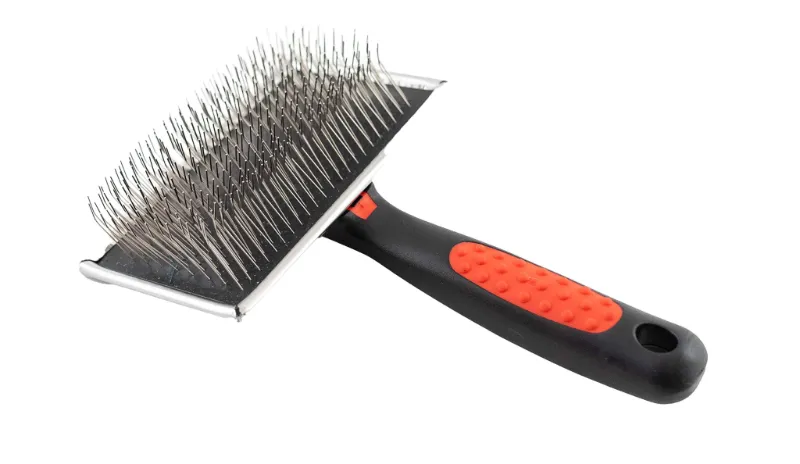
A slicker brush is a grooming device that consists of small angled wire pins that penetrate deep into the coat of your pet. You apply it to strip mats, tangles and loose undercoat. Groomers have used it over the years, particularly with high shedding breeds. The slicker brushes have most of the time a flat or curved head, ergonomic handle and the coated wires to prevent skin injuries. This brush is necessary in case you have a Poodle, Husky, or Australian Shepherd.
Features of Slicker Brush
- Bent/angled wire pins that penetrate deep into the coat to remove the mat and penetrate the undercoat.
- Curved, flat or rectangular heads that assist you to cover great distances in short time and evenly.
- The modern models have self cleaning features including retractable pins to save you time.
- Adjustable pin lengths to enable you to select short, medium or long pin length based on the thickness of the coat.
- Ergonomic grips that facilitate the grooming process and decrease the load on the wrist.
- Close set bristles, which trap fine hairs, dirt and debris.
- Soft or ball-tipped ones to consider sensitive pets, which will provide you with a softer choice in case of necessity.
Differences Between Pin Brush and Slicker Brush
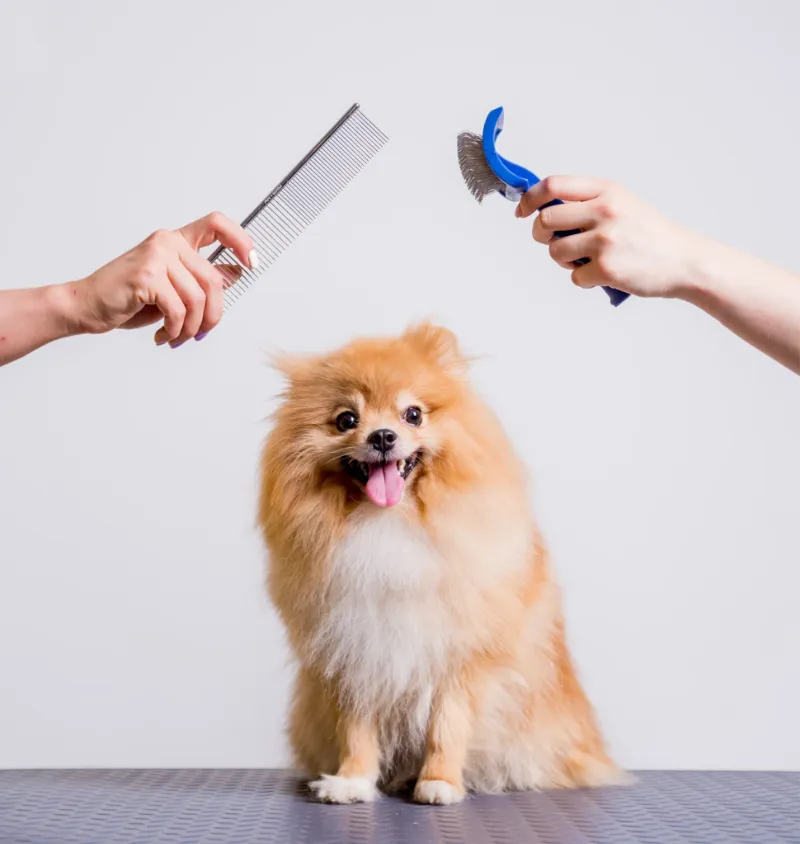
The brush you use on your pet is everything when grooming. The pin brush vs slicker brush conflict usually boils down to their design, softness and functionality. The brushes perform optimally in certain conditions and understanding these variations will enable you to groom better.
Pin Structure and Design
Looking at a pin brush, you will see straight pins which are far between and bearing rounded ends. These safety measures avoid scratches and allow brushing to be more convenient. Slicker brushes, in contrast, have fine wire bristles that are folded and stacked tightly together. The design allows them to penetrate deeper into thick fur, and it makes them more efficient in taking on mats.
Gentleness on Skin
The pin brush will be softer on the sensitive skin of your dog. The rounded ends slide well and minimize the possibility of irritation. However, slicker brushes may be rough when you are too rough. A light hand is needed with slickers in order to prevent discomfort or slicker burn.
Mats and Tangles Effectiveness
In the case of tough mats, the slicker brush is the most suitable. Its curved edges disentangle knots and tease thick masses of hair easily. A pin brush, however, is more effective in light detangling and mats prevention in the first place.
Coat Type Suitability
You will also want to match the brush with the coat of your pet. Long, silky, or straight coats are ideal when using pin brushes as they give it fluff and shine. Slicker brushes are better with curly, wiry, or double-coated breeds that shedding or mat forming.
Depth of Penetration
A slicker brush cuts deep, down to the undercoat. This will activate natural oils and maintain the health of the skin. Pin brushes are closer to the surface and they are good in styling, finishing and fluffing the outer coat.
User Ergonomics
Slicker brushes are also favored by many groomers to use during long grooming sessions because of their less wrist-straining form. Pin brushes can be more of a labor, but they also have a calming, massaging effect that your dog may like.
Finishing vs. Heavy-Duty Use
Imagine the pin brush as your finishing brush. It also flattens, polishes and spreads oils after grooming. The slicker brush, however, is your heavy-duty working-man. Clean it on the shedding, mats and debris first and then proceed to polish with the pin brush.
Comprehensive Comparison Table
| Pin Brush | Best For | Key Features |
|---|---|---|
| Pin Design | Straight, widely spaced with rounded tips | Fine, angled, densely packed wires |
| Best For | Long, silky, or medium coats; gentle detangling | Dense, matted, or undercoated fur; heavy shedding |
| Gentleness | High – Minimal skin irritation | Moderate – Can scratch if used improperly |
| Primary Function | Distributes oils, removes loose fur, prevents tangles | Removes mats, thins undercoat, stimulates skin |
| Coat Penetration | Surface-level to medium depth | Deep penetration for undercoat |
| Ease of Cleaning | Simple wipe-down | Often self-cleaning or requires combing out |
| Ideal Breeds | Golden Retrievers, Shih Tzus, Afghan Hounds | Huskies, German Shepherds, Pomeranians |
| Frequency of Use | Daily for maintenanceV | Weekly or as needed for mats/shedding |
| Price Range | $10–$30 | $8–$25 |
| Potential Drawbacks | Less effective on thick mats | Can pull hair if overused |
Benefits of Pin Brush
- Gently unfolds hair without pulling and pain, which is suitable to sensitive dogs.
- Creates a relaxing massage that activates blood and natural oils.
- Wet or dry coats: It works well and assists with the style and frizz.
- Cleans off loose hair and dirt, and does not mat in long coats.
- Flatten out coat and make shiny to improve the look of the coats.
- Favorite to dogs that do not like rough brushing, which serves as a preliminary device.
- Lessens breakage and static silky fur.
Benefits of Slicker Brush
- Removes mats, tangles and under coats effectively, without having to cut fur.
- Stimulates skin oils to achieve a healthier, more shiny coat and it minimizes dryness.
- Picks up dirt, debris and loose hair making the environment cleaner.
- Enhances blood circulation during grooming, and this keeps the skin healthy.
- Multi-purpose in the types of coats, particularly in shedding seasons.
- Eliminates future matting through maintenance of undercoats.
- Rapid day-to-day sessions assist in controlling outdoor rubbish of active dogs.
Applications of Pin Brush
The pin brush can be used in a number of ways to take care of your dog by maintaining the coat healthy and stylish. It is also good to use after bathing to fluff and smooth and provide a nice finish. In long haired breeds, using it every day will make you avoid those tangles before they become mats. You can even brush sensitive parts such as ears, legs or topknots without any pain. It spreads oils in coarse coats or in short coats when used in conjunction with a bristle brush. A pin brush can also be used to remove light debris post play, style silky breeds and also introduce puppies to grooming in a gentle manner.
Applications of Slicker Brush
One of the most useful grooming tools that you can have is a slicker brush. You find it easy to demat and detangle curly coats such as poodles or doodles. In the face of heavy shedding, it strips the heavy undercoat of the breeds that have two coats. You can loosen dirt and mats before a bath in order to clean easier. It is effective on energetic dogs after play outside and even gives the fine coats volume and shine. It can also be used by groomers to remove burrs; hence can be used on both cats and dogs.
Tips for Using Pin Brush
- Begin with wet fur with a conditioning spray to eliminate frizz and breakage.
- Brush against the direction of hair growth using long gentle strokes to make it smooth.
- Separate hair and brush along the roots to the ends to make sure there are no tangles.
- Wet coats: use when blow-drying to get the look without heat damage.
- Select the appropriate pad flexibility according to the type and sensitivity of your dog.
- Pair with snacks to make training fun to uncooperative dogs.
- Wash the brush frequently to keep it clean and efficient.
Tips for Using Slicker Brush
- Use some light pressure with short, patting strokes to prevent skin irritation.
- Brush with the fur growth direction, with the pat and pull method on mats.
- Begin at the back, and pull away unbrushed hair with your free hand.
- Stroke tangled parts with short strokes and longer ones over general grooming.
- Choose pin length depending on coat thickness–longer in thick fur.
- Give your dog treats when you are in hard places to develop tolerance.
- Clean the brush after every use, particularly self-cleaning models.
Mistakes to Avoid When Using Pin Brush or Slicker Brush
Applying Too Much Pressure
When using a slicker brush you can easily scratch your dog, so you should press firmly. Light and controlled strokes should always be used to be gentle yet still eliminate the tangles.
Stroking Hair Growth
The natural direction of the hair can be frizzy, broken or uncomfortable when touched. Always brush against the growth of the coats to achieve a smooth finish.
Using the Wrong Brush
A slicker brush used on a short haired dog will irritate the skin, and the pin brush cannot be effective on extreme mats. To avoid trouble, match the tool to the type of coat of your pet.
Failing to Clean the Brush
Brushes that have been dirty collect oils, dander, and hair that decrease efficiency and transmit bacteria. Always wash your brush after every use to keep it clean and working.
Wrong Brushing Motions
Do not make sideways flicks or twist the wrist. Such movements may drag fur in agony. Make straight, up-and-down lines, with even, steady strokes.
Excessive use on Sensitive Areas
Excessive slicker on the ears, belly or tail may be irritable, sometimes referred to as slicker burn. Restrict strokes in these areas and a lighter tool may be necessary.
Skipping Conditioning Sprays
Pain and static can be experienced when brushing a totally dry coat. Apply a light conditioning spray before the brushing to make the process easier and more comfortable to your dog.
Conclusion
Whether to use a pin brush or slicker brush depends on the type of coat and grooming requirements of your dog. A pin brush is used to keep long, silky coats smooth and shiny, and a slicker brush is used to deal with the mats, tangles and excessive shedding. Being familiar with the differences helps you to prevent any mistakes and you have a more comfortable experience with grooming your pet. Use soft tools such as a pin brush, then a slicker on more difficult tasks. Frequent grooming makes your bond stronger and guarantees perpetual health of your pet coat and skin.

